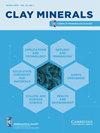粘土活化和胺链长度对二氧化硅-坡缕石异质结构性能的影响
IF 1.9
4区 地球科学
Q4 CHEMISTRY, PHYSICAL
引用次数: 1
摘要
摘要各种方法已被用于制备基于粘土矿物的异质结构材料,由此产生的功能材料具有许多潜在的应用。在本研究中,使用纤维状粘土矿物(坡缕石)和原硅酸乙酯试剂制备了二氧化硅-坡缕石异质结构。目的是强调制备过程中两个因素的影响:用HCl对坡缕石进行酸活化预处理的影响,以及改变所用胺链长度(十二胺和丁胺)对坡缕石纤维表面二氧化硅纳米颗粒形成和发展的影响。二氧化硅-坡缕石异质结构是在500°C下煅烧去除有机模板后获得的。使用各种实验表征技术,如X射线衍射、透射电子显微镜、气体吸附和傅里叶变换红外光谱,测定了二氧化硅-坡缕石异质结构样品的织构和结构性质。本研究中的实验变量似乎对所获得的二氧化硅-坡缕石异质结构的织构性质有显著影响。使用氮气和/或二氧化碳气体吸附测定的大的比表面积和中孔、微孔和超微孔体积证实了将纤维状粘土矿物的酸活化预处理与使用长链胺助表面活性剂(十二胺)相结合的益处。所得的二氧化硅-坡缕石异质结构具有较大的比表面积(628 m2 g–1)和发达的总孔隙网络(VN2=0.24 cm3 g–1;Vultra(CO2)=0.18 cm3 g–2)。该材料将进行测试,以去除低浓度的挥发性有机化合物。本文章由计算机程序翻译,如有差异,请以英文原文为准。
Effects of clay activation and amine chain length on silica–palygorskite heterostructure properties
Abstract Various approaches have been used for the preparation of heterostructured materials based on clay minerals, with numerous potential applications offered by the resulting functional materials. In this study, a fibrous clay mineral (palygorskite) and a tetraethyl orthosilicate reagent were used to obtain silica–palygorskite heterostructures. The aim was to highlight the influence of two factors during the preparation process: the effect of acid activation pre-treatment of the palygorskite with HCl and the effect of varying the length of the amine chains used – dodecylamine and butylamine – on the formation and development of silica nanoparticles on the surface of the palygorskite fibres. The silica–palygorskite heterostructures were obtained after the removal of the organic templates by calcination at 500°C. The textural and structural properties of the silica–palygorskite heterostructured samples were determined using various experimental characterization techniques, such as X-ray diffraction, transmission electron microscopy, gas adsorption and Fourier-transform infrared spectroscopy. The experimental variables targeted in this study appeared to have a significant effect on the textural properties of the silica–palygorskite heterostructure obtained. The great specific surface area and the mesoporous, microporous and ultramicroporous volumes as determined using nitrogen and/or carbon dioxide gas adsorption confirm the benefit of combining the acid activation pre-treatment of the fibrous clay mineral with the use of a long-chain amine co-surfactant (dodecylamine). The resulting silica–palygorskite heterostucture has a great specific surface area (628 m2 g–1) and a well-developed total pore network (VN2 = 0.24 cm3 g–1; Vultra (CO2) = 0.18 cm3 g–1). This material will be tested for the removal of volatile organic compounds at low concentrations.
求助全文
通过发布文献求助,成功后即可免费获取论文全文。
去求助
来源期刊

Clay Minerals
地学-矿物学
CiteScore
3.00
自引率
20.00%
发文量
25
审稿时长
6 months
期刊介绍:
Clay Minerals is an international journal of mineral sciences, published four times a year, including research papers about clays, clay minerals and related materials, natural or synthetic. The journal includes papers on Earth processes soil science, geology/mineralogy, chemistry/material science, colloid/surface science, applied science and technology and health/ environment topics. The journal has an international editorial board with members from fifteen countries.
 求助内容:
求助内容: 应助结果提醒方式:
应助结果提醒方式:


